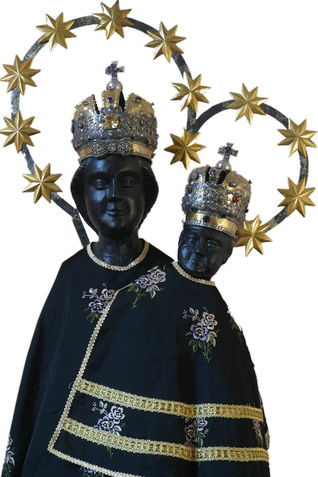
Ancient Shrine at Vinski Vrh (1499-1545)
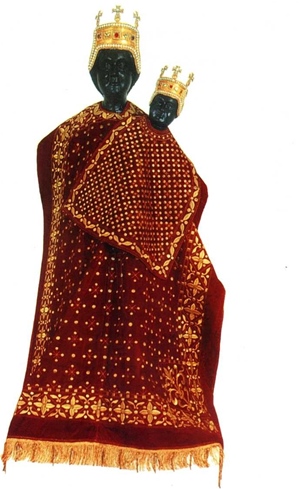
The shrine of the Mother of God of Bistrica has a long, centuries-old history. The miraculous wooden black statue of the Holy Virgin originates from the 15 th century, and it is the work of an unknown local master devoted to believers who suffered heavy misfortune. Popular traditions says that the black wooden statue of the Mother of God (Vinnska) was first venerated in a wooden chapel, the earliest shrine of Bistrica, at Vinski Vrh from 1499 to 1545. Vinski Vrh is situated above the valley of the river Krapina and Zlatarsko Polje at an altitude of 282m, between Marija Bistrica and Konjščina, about three kilometres away from today's shrine in Marija Bistrica. Due to the permanent Turkish danger, especially after the Turks defeated the army of Nikola Zrinski at Konjščina on May 4, 1545, the parish priest Pavao (plebenus Paulus de Bisthriza) transferred the miraculous statue of Our Lady to Bistrica and buried it secretly under the choir of the parish church. He took the secret about the statue with him to his tomb.
The First Finding of the Miraculous Statue in 1588
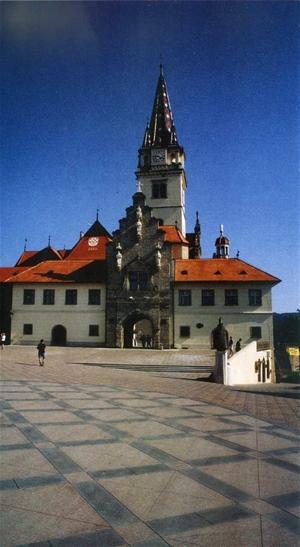
Our Lady’s followers were con- stantly searching for the miraculous statue. The uncertainty was re- solved by a strange light coming from the choir of the parish church in Bistrica after the evening service. The folowing day the undamaged statue of Our Lady was unearthed. It was in 1588 during the parish priest Luka’s tenure, and, according to some documents, the parish priest Antun Plavasic’s (1574T590). This was the first finding of the statue of the Mother of God of Bistrica and its setting up on the altar for worship.
The Hiding Again of the Miraculous Statue in 1650
Due to constant Turkish danger, when the Turks invaded the country as far as Zlatarsko Polje in 1650, the statue was hidden for the second time. It was placed in the area be- hind the main altar in the parish church and walled in, but an opening was left for Our Lady’s face. Pilgrimages to Bistrica became less be-cause of the constant Turkish invasions, peasants’ revolts, and the fact that the statue was hidden.
On the second Sunday of September, Our Lady twice appeared to the parish priest Petar Brezaric (1676-1679). In the parish church in the morning, while he was preaching about St Francis Xavier (Franjo Ksaverski). All at once a woman of noble appearance, dressed in blue clothes, approached the pulpit, with a burning candle in her hand, pleading with the priest to pray, together with the congregation, for her sight. The same day in the afternoon, the same “lady” appeared to him in the hamlet of Podgrade, near the house of the Balogovic family, while he was riding in a carriage, together with the chaplain, on his way to the manor of Malenici. When he tried to approach her, “the lady” disappeared. There was a lot of talk about that apparition even after Brezaric’s death, but without having much importance attached to it. Nevertheless, it was surely the Virgin Mary’s plea to be able to see again behind the altar wall, where the black statue of Our Lady of Bistrica was walled in.
The Second Finding of the Miraculous Statue in 1684
Through the efforts of old Martin Borkovic (1667-1687), a great wor-shiper of Our Lady, a monastic Paulist, and a general of the Pauline order, and later bishop of Zagreb, the black miraculous statue of Our Lady was found again. In a discussion regarding the greatest Croatian parish festival-site of Our Lady, the eighty-seven year old bishop asked the parish priest of Bistrica, Ivan Molitoris (1679-1688): “Is it true that the Mother of God is venerated in Bistrica more than anywhere else?” The parish priest of Bistrica was confused by the question which was in fact a claim. Bishop Martin Borkovic, remembering his young days when he went on pilgrimage to Bistrica barefoot, ordered the Zagreb canon Matija Stoklas and the Bistrica parish priest Ivan Molitoris to look once more for the miraculous statue of Our Lady.
The second finding of the statue took place on July 15, 1684. The fob lowing day, on Sunday July 16, 1684 (St. Margaret’s Sunday) the first miracle happened - a paralysed girl Katarina, Magdalena Paulec’s daughter, got back on to her feet. The newly found (and for a time forgotten) statue of Our Lady was placed on a side altar and handed over to pilgrims for worship. Word of this miraculous finding of the statue of the Mother of God of Bistrica again, as well as the telling of the miraculous healing, got around not only to the large Zagreb diocese but also in Styria and Hungary. Streams of pilgrims or parish shrine visitors began to flow towards Bistrica. The parish priest of Bistrica, Andrija Ifsic (1688-1719), became renowned for promulgating the adoration of the Mother of God of Bistrica. In 1706, he renounced the duty of a canon in the Zagreb cathedral chapter in order to devote himself to further spreading devotion for th. miraculous Our Lady of Bistrica. 1 e Most Holy Virgin, under the name ot the Mother of God of Bistrica, has been celebrated in Marija Bistrica <ince the miraculous statue was exposed to the public again in 1684.
The Croatian Parliament and the Parish Site of Pilgrimage in Bistrica
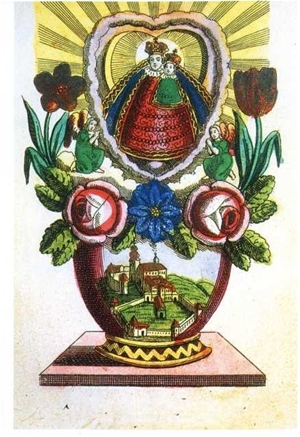
The Croatian Parliament (Parlia- ment) in Zagreb decided, on Octo- ber 20, 1710, to erect a new main ah tar in honour of the Blessed Virgin Mary in the parish church of the saint apostles Peter and Paul, as a plea for the protection against the plague. This decision was re-con- firmed on May 28, 1711. The Cn> atian Parliament thus elevated the parish shrine at Bistrica to state level. This promise by the Croatian Parliament was fulfilled in 1715 when it had the main altar erected, at its own ex- pense, on which the statue of the Mother apostles Peter and Paul, as the original patrons of the Bistrica parish, stood next to it. The altar remained at the Bistrica shrine until 1791 when it was removed for unknown reasons.
In order to facilitate the approach to the Bistrica parish holy site, the Croatian Parliament had a road built in 1721 from Kasina through Laz to Bistrica . In 1753 it also had the road from Zagreb, through Sesvete and Kasina, to Bistrica repaired, so that pilgrims from Zagreb and Posavina could come more easily to Bistrica.
The Consecration of the Parish Church in 1731
At the beginning of the 18 th cem tury, during the time of the parish priest Andrija Ifsic (1688-1719) and the priest Ivan Radic (1722-1730), the old parish church was extended and reorganized as the parish pib grimage church in Baroque style. It was consecrated by the Zagreb bishop Juraj Branjug (1723-1748) on the day of St Margaret, July 13, 1731. During the consecration of the church, the name of the parish church of the saint apostles Peter and Paul was changed into the par~ ish and church of Our Lady of the Snows (church holiday August 5), i.e. the Mother of God of Bistrica. The very place was named Marija Bistrica by the decision of the Croatian Parliament. The celebration of God’s Face or Our Lord’s Transfigm ration (church holiday August 6). and thus the introduction of the par- ish festival of God’s Face in the first days of the month of August, musr be attributed to bishop Jura; Branjuga. (The proofs are the pul pits from his Baroque workshop it Cucerje and Komin). According the records of canonical visitation * the newly-arranged church w . completely decorated with Baroqu fresco paintings, in which wer placed, next to the main altar, a precious sculpture, Baroque side altar', a pulpit, a baptismal font and an organ.
The Parish Courtyard, Cloisters and a New Altar
The parish priests of Bistrica lived in a wooden house like the pa- rishioners. In 1726 the parish priest IvanRadic (1722-1730) built anew walled parish courtyard (today’s western area). Then parish priest Pavao Gojmerec (1735-1753) built a new building in 1748 (today’s eastern section) on the site of the wooden house, and the parish priest Pavao Jurak (1753-1775) in 1753, with additional building, connected the two making a single dwelling, which still exists today to the right of the basilica.
To make easier confession and Communion for pilgrims, parish priest Pavao Gojmerec began to built cloisters in 1748 around the church in order to obtain an enclosed parish pilgrimage area. The cloisters consisted of forty-one arcades, painted following the story of Bistrica miracles, which has such a strong impact on pilgrims. Above the main entrance from the north side, so called railing, there was a sanctuary for pilgrims, and above the entrai ce from the western side in front of the facade of the church, the so called Gamula, there was a room with a small Capuchin tower for friar confessors. The third and southerly entrance led to the parish courtyard. Such cloisters are a typical Baroque characteristic of parish celebratery churches of the Zagreb diocese (Marija Bistrica, Trski Vrh, Lobor, Belec, Komin, Ludberg ...).
The parish priest Josip Sandor Dalski (1786-1818) in 1791 built a new classicist altar for the miraculous statue of the Mother of God of Bistrica. This altar miraculously was undamaged in the fire of 1880. However, the destiny of that altar, as well as the votive Baroque altar of the Croatian Parliament of 1715, remained unknown.
The Prayer-book of the Chaplain Petar Berke (1765 and 1775)
The priest Petar Berke (1734- -1798) was a chaplain for German speaking pilgrims in Marija Bistrica (1759-1761). As a previous chaplain in Bistrica, Petar Berke wrote, in kajkavian Croatian dialect, the first pilgrim’s prayer-book and a short history of the Marija Bistrica parish festival site, under the title. “Miraculous appearances and graces which have appeared for many years at the miraculous statue of Marija Bistricka”. The first edition was published in Zagreb in 1765, and the second edition in Graz in 1775. The reprint of the second edition was published in Zagreb in 1995, with a note saying that it was the oldest printed memorial book about the miraculous parish site of the Mother of God of Bistrica, which witnessed the spreading of the worship of Our Lady, pilgrimages and the life of the parish pilgrimage site from 1684 to 1775. Because of its contents, the prayer-book is a precious document about the pastoral pilgrimages of the 18th century. It is a significant source for the history of the Croatian language due to its kajkavian linguistic features, phrases, lexis and syntax. A stokavian-ikavian shortened version of Berke’s book was published by the teacher Antun Mihalj in 1822 under the title “Put Marianski na Bistricu, k cudovito- mu kipu Marie Bistricke u slavnom kraljevstvu horvatskomu” (The way to Marija Bistrica, towards the miraculous statue of the Mother of God of Bistrica in the well-known kingdom of Croatia). Berke’s pra-yer-book brought the first published list of parishes and regions from which the processions came to the shrine of the Mother of God of Bistrica.
Privileges of Rome and Dangers of Enlightenment
The Prelates of Rome bestowed pilgrim privileges on the shrine of Bistrica. Pope Benedict XIV (1740" 1758), in the Year of the Saints of 1750, bestowed the privb lege of complete absolution on all pilgrims who confessed and received Communion in Marija Bistrica, and completed the prescribed prayers. Pope Clement XIII (1758*1769) permitted the foundation of the Brotherhood of Saint Scapular.
The Bistrica parish shrine was in danger again through the Enlight" enment ideas put forward during the reign of the Empress and Queen, Maria Theresa (1740-1780). The imperial court sent to the Croatian Royal Council in Varazdin “the Intimatum”, a decree of May 27, 1774 by which the Empress forbade all processions which lasted more than one day. The decree consisted of seventeen items, of which item number seven directly referred to the parish shrine of Bistrica. It re" fleeted a fear of public disturbances and the Enlightenment care about idleness of serfs and peasants. The Zagreb bishop Josip Galjuf (1772" 1786) protested resolutely defending the right of pilgrimage to Marija Bistrica, because pilgrims from all over Croatia and the sun rounding lands were coming to Bistrica. Bishop Galjuf requested that the processions might proceed as the populace had great benefit from them. The Croatian Royal Council in Varazdin compared the Croatian Marija Bistrica with the Austrian Maria Zella and supported the protest of the Zagreb bishop Josip Galjuf made to the imperial court in Vienna. Among other things, he mentioned that pilgrims to Marija Bistrica were also non-united Greeks, i.e. Croatian Orthodox followers. Finally, the Em- press and Queen, Maria Theresa permitted processions to the parish shrine of the Mother of God of Bistrica in her letter of June 7, 1775. A procession was a synonym for a pilgrimage at that time, and in Hrvatsko Zagorje it still is today.
The Zagreb bishop Maksimilijan Vrhovac (1787-1827) also defended the right of Bistrica to hold proces sions (and thus the very existence of the parish shrine of Bistrica), in his letter of July 21, 1810, to the impe- rial and royal minister of internal affairs Hager in Vienna. Vienna was afraid of public disturbances in Marija Bistrica because the pilgrims were not only from Croatia, Slavonia, Styria and Hungary but also from Bosnia and also the Croats and men from Carniola, from Napoleonic Illyria south of the river Sava. From that time there still exists the timetable of the days of absolution between Whit Sunday and Thanksgiving Sunday before All Saints day.
Today's Church, the New Altar and the Arcades
(1845-1926) fromhisowndrawings.
The old church was extended and made higher, and the bell-tower and some newarcades were built with
rooms for priests, pilgrims and eon- fessors, together with the chapels of St Joseph and Catherine, all in
neo-Renaissance sryle. The parish premises were also extended and renovated, as well as outhouses,
while the shrine received the look of a fort or a town on the mount.
During building, on August 14, 1880, on the eve the Feast of the Assumption of the Yirgin Mary, a fire
broke out and destroyed the whole interior of the church, except for the main altar with the miraculous
statue of the Mother of God of The look of the parish church in Marija Bistrica today dates from the
eighties of the 19th century. Significant building works were carried out between 1879 and 1882, during the
time of the Zagreb archbishop, cardinal Josip Mihalovia (1870-1891), and the parish priest Juraj Žerjavić
(1874-1910). The parish priest juraj Žerjavia and the minister Iso Kršnjavi in 1875 founded the Trust-
eeship for the Renovation of the Bistrica Shrine. Karoly Benko from Budapest (1875), Matija Antoles
(1877) and Hermann Bolle' (1879) from Zagreb took part in a cornpetition. The renovation of the shrine
began on May 10, 1879. According to Iso Kršnjavi's wish, the works were reconstructed by Herman Bolle'
Bistrica. During the renovation of the shrine, and after the fire, the Sisters of Mercy kept the miraculous
statue in their convent. The new marble neo-Renaissance altar, the gift of the Croatian Parliament, was eon-
secrated by the archbishop, cardinal Joseph Mihalovia on June 3, 1883. The priest from Zlatar Stjepan
Mihinia de live red a sermon. After the renovation of the shrine, during the time of the parish priest Juraj
Žerjavia, all the statues of Austrian and Hungarian rulers were removed. Pope Leon XIII (1878-1903)
gave a donation to the renewed shrine of Bistrica, on the occasion of his anniversary, consisting of a guilt
pedestal for the miraculous statue of the Mother of God of Bistrica.
The Shrine Church Became a Basilica in 1923
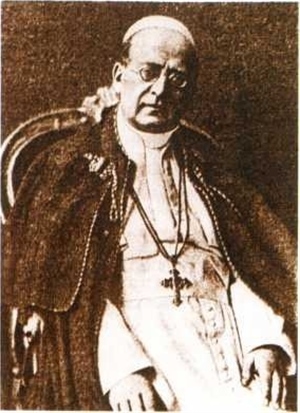
Due to the fact that the shrine of the Mother of God of Bistrica in Marija Bistrica was the foremost among Mary’s other shrines in Croatia, and at the request of the Zagreb archbishop Antun Bauer (1914'1937), Saint Father Pius XI (1922'1939) bestowed on the shrine and parish church in Marija Bistrica the title and rights of a minor basil' ica (basilica minor); it happened on December 4, 1923. Rome’s prelates bestow such a title of a minor basib ica only on major cathedrals, parish churches and shrines.
The Crowning of the Miraculous Statue of the Queen of the Croats in 1935
Since the late Middle Ages, the custom has been established to crown Mary’s figures, icons, images or statues with a specially blessed crown. With the permission of the Canonical Chapter of the Roman basilica of St Peter, who were re- sponsible for the crowning of Mary’s figures, the Zagreb archbishop Antun Bauer crowned the miraculous statue of the Mother of God of Bistrica on Sunday, July 7, 1935, on the 250th anniversary of the second finding of the statue. It was crowned with two celebratery golden crowns; the Holy Virgin was crowned with the bigger crown and the child Jesus with a smaller one. The crowns were made in the pattern of old Croatian royal crowns and were the gift of the Croatian people. The sermon and consecration for the occasion, in front of 30.000 pilgrims, was delivered by the then archbishop -co-adjutor blessed Alojzije Stepinac. Then the city of Zagreb donated to the shrine of Bistrica a golden chalice, and Croatian belie v- ers a golden rosary. On that occa- sion, the Zagreb archbishop and Croatian metropolitan Antun Bauer proclaimed the Most Holy Virgin Mary - the Mother of God of Bistrica, the Queen of the Croats:
“Celestial Virgin, the Queen of the Croats, our Mother, our golden dawn, receive the gift of devoted hearts, receive the ardour of our pure love.”
This refrain of the welbknown devotional poem to Mary, composed by the martyr f. Petar Perica, D.I.,has since practically become the hymn of Mary’s Croatian worshipers.
The statue of the Mother of God of Bistrica was crowned with gilt crowns even in the 17 th century, but not in a solemn ceremony according to the church’s prescriptions. The heads of the Mother of God and the Little Jesus from the miraculous statue of Bistrica were often crowned with these old crowns. The celebratery golden crowns are placed on the black Virgin’s statue only during the Zagreb pilgrimage on the second Sunday of the month of July.

